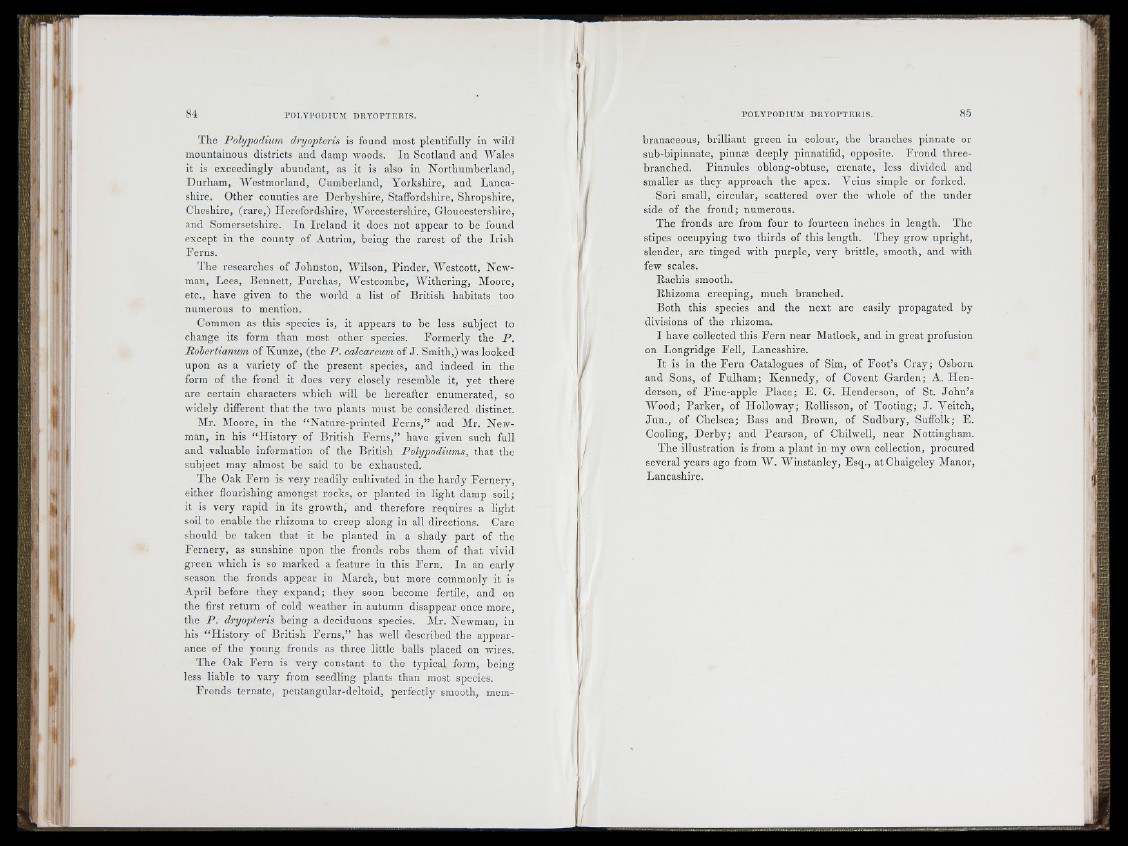
T h e Pohjpodium dryopteris is found most plentifully in wild
mountainous districts and damp woods. In Scotland and Wales
it is exceedingly abundant, as it is also in N orthumberland,
Durham, Westmorland, Cumberland, Yorkshire, and Lancashire.
Other counties are Derbyshire, Staffordshire, Shropshire,
Cheshire, (ra re ,) He refordshire, Worcestershire, Gloucestershire,
and Somersetshire. In Ire la n d it does not appear to be found
except in the county of An trim, being the ra re st of the Irish
Lerns.
The researches of Johnston, Wilson, F in d e r, Westcott, N ew man,
Lees, Bennett, Purch a s, Westcombe, W ith e rin g , Moore,
etc., have given to the world a list of B ritish habitats too
numerous to mention.
Common as this species is, it appears to be less subject to
change its form than most other species. Forme rly the P .
Mohertianum of K unze, (the P . calcareum of J . Smith,) was looked
upon as a variety of the present species, and indeed in the
form of the frond it does very closely resemble it, y e t there
are certain characters which will be hereafter enumerated, so
widely different th a t the two plants must be considered distinct.
Mr. Moore, in the “ N a tu re -p rin ted F e rn s ,” and Mr. N ew man,
in his “ H isto ry of British F e rn s,” have given such full
and valuable information of the British Polypodiums, th a t the
subject may almost be said to be exhausted.
The Oak F e rn is v ery readily cultivated in the h a rd y F e rn e ry ,
e ither flourishing amongst rocks, or planted in light damp soil;
it is very rap id in its growth," and therefore requires a lig h t
soil to enable the rhizoma to creep along in all directions. Care
should he taken th a t it be planted in a shady p a rt of the
F e rn e ry , as sunshine upon the fronds robs them of th a t vivid
g reen which is so marked a feature in this F e rn . In an early
season th e fronds appear in March, b u t more commonly it is
A p ril before they ex p an d ; they soon become fertile, and on
the first re tu rn of cold weather in autumn disappear once more,
the P . dryopteris being a deciduous species. Mr. Newman, in
his “ Histo ry of British F e rn s ,” has well described the appearance
of the young fronds as th re e little balls placed on wires.
T he Oak F e rn is very constant to the typical form, being
less liable to vary from seedling plants than most species.
F ro n d s ternate, pentangular-de ltoid, perfe ctly smooth, membranaceous,
b rilliant green in colour, the branches pinnate or
sub-hiplnnate, pinnæ deeply pinnatifid, opposite. F ro n d three-
branched. Pinnules oblong-obtuse, crenate, less divided and
smaller as th ey approach the apex. Veins simple or forked.
Sori small, circular, scattered over the whole of the under
side of the frond; numerous.
The fronds are from four to fourteen inches in length. The
stipes occupying two th ird s of this length. They grow u pright,
slender, are tinged with p u rp le , very b rittle , smooth, and with
few scales.
Hachis smooth.
Rhizoma creeping, much branched.
B oth this species and the n ex t are easily propagated by
divisions of the rhizoma.
I have collected this F e rn near Matlock, and in great profusion
on L ongridge F e ll, Lancashire.
I t is in the F e rn Catalogues of Sim, of Foot’s C ray ; Osborn
and Sons, of F u lh am ; K en n ed y , of Co vent G a rd en ; A. H e n derson,
of Pine-apple P la c e ; E . G. Henderson, of St. Jo h n ’s
"Wood; P a rk e r, of Holloway; Rollisson, of T ooting; J . Veitch,
Ju n ., of Chelsea; Bass and Brown, of Su d b u ry , Suffolk; E .
Cooling, D e rb y ; and Pearson, of Chilwell, near Nottingham.
T he illustration is from a plant in my own collection, procured
several years ago from W . Winstanley, E sq ., a tC h a ig e ley Manor,
Lancashire.